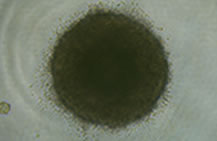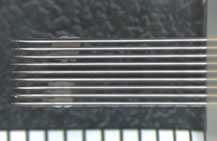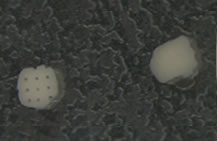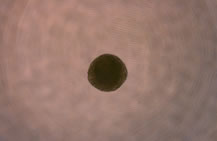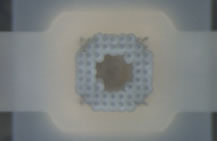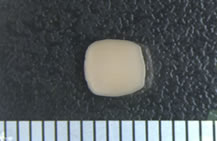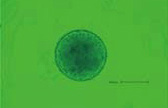| 产品编号 | 产品名称 | 产品规格 | 产品等级 | 产品价格 |
| MS-9035XZ | PrimeSurface 35mm dish PrimeSurface 35mm 培养皿 |
50个 | – | – |
| MS-9060XZ | PrimeSurface® 培养皿60mm |
100个 | ||
| MS-9090XZ | PrimeSurface® 培养皿90mm |
50个 | ||
| MS-9024XZ | Sumiron Celltight 板24F | 10个 | ||
| MS-9384UZ | PrimeSurface® 384U多孔板 |
0.1mL | ||
| MS-9384WZ | PrimeSurface® 384U白色多孔板 |
0.1mL | ||
| MS-9096VZ | PrimeSurface® 96V多孔板 |
0.3mL | ||
| MS-9096MZ | PrimeSurface® 96M多孔板 |
0.2mL | ||
| MS-9096UZ | PrimeSurface® 96U多孔板 |
0.3mL | ||
| MS-9096WZ | PrimeSurface® 96U白色多孔板 |
0.3mL |
- 产品特性
- 相关资料
- Q&A
- 参考文献
 低吸附相关试剂
低吸附相关试剂
PrimeSurface 低吸附细胞培养板
PrimeSurface® 是采用sumiron公司的低吸附蛋白质处理产品(Proteosave®SS)的技术制成的低吸附细胞处理产品。使用该容器培养细胞更容易形成细胞球集落。
◆特长
● 能够简单地形成细胞集落
将细胞播种在96、384多孔板中,静置培养就能简单地得到细胞集落。
● 细胞集落大小均一
抑制细胞吸附在培养面,集落的形成率得到了提高,能够在细胞形态平整、均一的状态下培养。
● 适用于细胞分化的研究
能够将ES细胞变成胚叶体(EB体)后直接添加分化诱导试剂
● 最适合用于使用细胞球进行抗癌剂的筛选
进行3D培养,与常规的单层培养相比培养环境更加接近生物体。
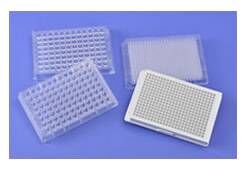
◆用途
用于再生医疗和药物研发中
◆细胞培养
● ES细胞·IPS细胞·骨髓间充质干细胞的分化诱导
● 使用细胞的3D模型进行药物研发筛选
◆产品概要
|
产品编号 |
产品名称 |
规格 |
培养面积 |
容量 |
包装 |
|
MS-9035XZ |
PrimeSurface® 培养皿35mm |
外寸35Φ×14(H)mm |
9cm2 |
– |
5包·50/case |
|
MS-9060XZ |
PrimeSurface® 培养皿60mm |
外寸60Φ×15(H)mm |
21cm2 |
– |
10包·100/case |
|
MS-9090XZ |
PrimeSurface® 培养皿90mm |
外寸90Φ×20(H)mm |
57cm2 |
– |
10包·50/case |
|
MS-9024XZ |
Sumiron Celltight 板24F |
24孔·平底 |
1.8cm2 |
3.4mL/well |
1包·10/case |
注:已进行放射线灭菌 保存温度:室温 有效期:制造后两年
|
产品编号 |
产品名称 |
孔数 |
孔底形状 |
容量 |
包装 |
|
MS-9384UZ |
PrimeSurface® 384U多孔板 |
384 |
U底 |
0.1mL |
1/包・20/case |
|
MS-9384WZ |
PrimeSurface® 384U白色多孔板 |
384 |
U底 |
0.1mL |
1/包・20/case |
|
MS-9096VZ |
PrimeSurface® 96V多孔板 |
96 |
V底 |
0.3mL |
1/包・20/case |
|
MS-9096MZ |
PrimeSurface® 96M多孔板 |
96 |
纺锤底 |
0.2mL |
1/包・20/case |
|
MS-9096UZ |
PrimeSurface® 96U多孔板 |
96 |
U底 |
0.3mL |
1/包・20/case |
|
MS-9096WZ |
PrimeSurface® 96U白色多孔板 |
96 |
U底 |
0.3mL |
1/包・20/case |
注:已进行放射线灭菌 保存温度:室温 有效期:制造后两年
◆实验例子
在用球体制作工程构建三维结构体时使用了Cyfuse的生物3D打印机Regenova®
Regenova®是世界最先进的机器人系统,它通过将球体固定在剑山,再按照3D设计制作出三维结构体。下面为大家介绍使用了该系统的神经三维结构体和使用了间充质干细胞的三维结构体的实验例子。
神经三维结构体
使用细胞:人iPSC来源神经前驱细胞
播种数:4×104 cells/well
培养基:神经细胞用培养基
培养板培养天数:2天
制作出的三维结构体的形状、尺寸:3×3×2
用于三维结构体的细胞块个数:18个
积层后的培养天数:9天后拔出剑山
|
|
|
|
|
细胞块 |
3D打印后 |
拔出剑山后的三维结构体 |
使用间充质干细胞的三维结构体
使用细胞:人脂肪组织来源间充质干细胞
播种数:5×103 cells/well
培养基:间充质干细胞用培养基
培养板培养天数:2天
制作出的三维结构体的形状、尺寸:用48个细胞块组成环状×10层
用于三维结构体的细胞块个数:480个
积层后的培养天数:6天后拔出剑山
|
|
|
|
|
|
细胞块 |
3D打印后(上面) |
3D打印后(侧面) |
拔出剑山后 |
使用PrimeSurface® 96U多孔板的培养例子
小鼠ES细胞培养
播种数:750cells/well
培养基:DMEM+4.5mg/mLGlc.
添加物:15%灭活FCS
2mML-谷氨酰胺
1%非必须氨基酸
110μM2-巯基乙醇
培養日数:3日
|
|
没有细胞吸附在PrimeSurface® 96U多孔板上,也没有凌乱的细胞集落,已经形成均一。 |
|
|
一般市面上贩卖的漂浮培养用多孔板,细胞紧密粘附或者死亡。 |
使用PrimeSurface® 96U多孔板的细胞分化诱导实验例子
使用PrimeSurface® MS-9096V将人ES细胞集落导入自身组织化神经网膜组织
培养器:PrimeSurface® MS-9096V
使用细胞:人ES(KhES-1株)
播种密度:9000 cells/well
使用培养基:GMEM+KSR+NEAA+2ME+ 20uM Y-27632
培养条件:5% CO2,37℃
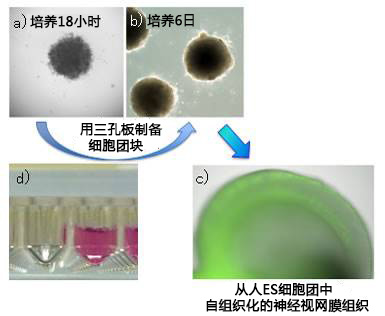
【数据提供】
・照片a)~c)
理化学研究所 发生与再生科学综合研究中心 干细胞研究支援开发室
【参考文献】
・Self-Formation of Optic Cups and Storable Stratified Neural Retina from Human ESCs
NakanoT, Ando S, Takata N, Kawada M, Muguruma K, Sekiguchi K, Saito K, Yonemura S, Eiraku M, Sasai Y
Cell Stem Cell, 10 (6), 771-785 (2012)
使用PrimeSurface® 进行抗癌药药效测试实验
细胞:MCF-7(人乳腺癌细胞)
试剂:5-Fluorouracil(5-FU)
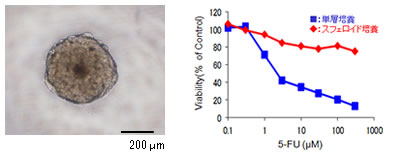
【数据提供】
・近畿大学医学部 基因组生物学教室 西尾研究室
在小鼠ES细胞形成球体引起心肌细胞分化的过程中使用DS Pharma Biomedical的心肌分化毒性(发生毒性)评价试剂盒。
POCA® Hand1-EST
POCA® Hand1-EST是一种使用PrimeSurface,在待测物存在下的培养中将检测小鼠ES细胞的心肌分化是否正常作为标记基因活性的指标的方法。
使用细胞:小鼠ES细胞(Hand1-ES细胞)
播种数:750 cells/well
培养基:心肌分化培养基
培养板培养天数:5天

|
研究领域 |
使用型号 |
参考文献 |
|||||||||||||||||||||||
|
视网膜 研究 |
MS-9096V |
KUWAHARA, Atsushi, et al. Generation of a ciliary margin-like stem cell niche from self-organizing human retinal tissue. Nature communications, 2015, 6.: 1-15 |
|||||||||||||||||||||||
|
MS-9096V |
TANAKA, T., et al. Generation of retinal ganglion cells with functional axons from human induced pluripotent stem cells. Sci Rep, 2015, 5. 8344. |
||||||||||||||||||||||||
|
MS-9096U |
EIRAKU, Mototsugu and SASAI, Yoshiki Mouse embryonic stem cell culture for generation of three-dimensional retinal and cortical tissues. Nature protocols, 2012, 7. 1: 69-79. |
||||||||||||||||||||||||
|
MS-9096V |
NAKANO, Tokushige, et al. Self-Formation of Optic Cups and Storable Stratified Neural Retina from Human ESCs. Cell Stem Cell, 2012, 10. 6: 771-785. |
||||||||||||||||||||||||
|
MS-9096V |
GAO, Lixiong, et al. Intermittent high oxygen influences the formation of neural retinal tissue from human embryonic stem cells.Scientific Reports, 2016, 6. |
||||||||||||||||||||||||
|
神经科学 研究 |
MS-9096V |
MUGURUMA, Keiko, et al. Self-Organization of Polarized Cerebellar Tissue in 3D Culture of Human Pluripotent Stem Cells. Cell Reports, 2015, 10:537-550 |
|||||||||||||||||||||||
|
MS-9096V |
BAMBA, Y., et al. Differentiation, polarization, and migration of human induced pluripotent stem cell-derived neural progenitor cells co-cultured with a human glial cell line with radial glial-like characteristics. Biochem Biophys Res Commun, 2014, 447. 4: 683-688. |
||||||||||||||||||||||||
|
MS-9096 U, M or V |
MINAMINO, Yuki, et al. Isolation and Propagation of Neural Crest Stem Cells from Mouse Embryonic Stem Cells via Cranial Neurospheres. Stem cells and development, 2014, 24.2: 172-181 |
||||||||||||||||||||||||
|
MS-9096V |
KADOSHIMA, T., et al. Self-organization of axial polarity, inside-out layer pattern, and species-specific progenitor dynamics in human ES cell-derived neocortex. Proceedings of the National Academy of Sciences of the United States of America, 2013, 110. 50: 20284-20289. |
||||||||||||||||||||||||
|
MS-9096 U, M or V |
OGAWA, Yasuhiro, et al. Impaired neural differentiation of induced pluripotent stem cells generated from a mouse model of Sandhoff disease. PLoS ONE, 2013, 8. 1: e55856. |
||||||||||||||||||||||||
|
MS-9035X |
GOMI, Masanori, et al. Functional recovery of the murine brain ischemia model using human induced pluripotent stem cell-derived telencephalic progenitors. Brain research, 2012, 1459. 52-60. |
||||||||||||||||||||||||
|
MS-9096 U, M or V |
NASU, Makoto, et al. Robust formation and maintenance of continuous stratified cortical neuroepithelium by laminin-containing matrix in mouse ES cell culture. PLoS ONE, 2012, 7. 12: e53024. |
||||||||||||||||||||||||
|
MS-9096 U |
DANJO, T., et al. Subregional specification of embryonic stem cell-derived ventral telencephalic tissues by timed and combinatory treatment with extrinsic signals. The Journal of neuroscience : the official journal of the Society for Neuroscience, 2011, 31. 5: 1919-1933. |
||||||||||||||||||||||||
|
MS-9096 U |
KANEMURA, Yonehiro Development of cell-processing systems for human stem cells (neural stem cells, mesenchymal stem cells, and iPS cells) for regenerative medicine. The Keio journal of medicine, 2010, 59. 2: 35-45. |
||||||||||||||||||||||||
|
MS-9096 U, M or V MS-9035X, MS-9060X or MS-9090X |
FUKUSUMI, Hayato, et al. (2016). Establishment of human neural progenitor cells from human induced pluripotent stem cells with diverse tissue. Stem cells international: 1-10. |
||||||||||||||||||||||||
|
MS-9096 U, M or V |
RAASCH, Martin, et al. (2016). An integrative microfluidically supported in vitro model of an endothelial barrier combined with cortical spheroids simulates effects of neuroinflammation in neocortex development. Biomicrofluidics. 10: 044102. |
||||||||||||||||||||||||
|
MS-9096 M |
ISODA, Miho, et al. (2016). Robust production of human neural cells by establishing neuroepithelial-like stem cells from peripheral blood mononuclear cell-derived feeder-free iPSCs under xeno-free conditions. Neuroscienc Research. |
||||||||||||||||||||||||
|
MS-9035X, MS-9060X or MS-9090X |
BAMBA, Yohei, et al. (2016). In vitro characterization of neurite extension using induced pluripotent stem cells derived from lissencephaly patients with TUBA1A missense mutations. Molecular brain. |
||||||||||||||||||||||||
|
MS-9096V |
SAKAGUCHI, Hideya, et al. (2015). Generation of functional hippocampal neurons from self-organizing human embryonic stem cell-derived dorsomedial telencephalic tissue. Nature communications. 6: 1-11. |
||||||||||||||||||||||||
|
MS-9096V |
MUGURUMA, Keiko, et al. Self-Organization of Polarized Cerebellar Tissue in 3D Culture of Human Pluripotent Stem Cells. Cell Reports, 2015, 10:537-550 |
||||||||||||||||||||||||
|
KAMIYA, Daisuke, et al. Intrinsic transition of embryonic stem-cell differentiation into neural progenitors. Nature, 2011, 470. 7335: 503-509. |
|||||||||||||||||||||||||
|
心肌细胞 研究和心脏研究 |
MS-9096V |
TAKASHIMA, Yasuhiro, et al. Resetting transcription factor control circuitry toward ground-state pluripotency in human. Cell, 2014, 158. 6: 1254-1269. |
|||||||||||||||||||||||
|
MS-9035X |
OTSUJI, Tomomi G, et al. Dynamic link between histone H3 acetylation and an increase in the functional characteristics of human ESC/iPSC-derived cardiomyocytes. PLoS ONE, 2012, 7. 9: e45010. |
||||||||||||||||||||||||
|
MS-9096U |
SATOSHI, Yasuda, et al. AW551984: a novel regulator of cardiomyogenesis in pluripotent embryonic cells. Biochemical Journal, 2011, 437. 2: 345-355. |
||||||||||||||||||||||||
|
MS-9096U |
YASUDA, S., et al. A novel regulator of cardiomyogenesis in pluripotent embryonic cells. The Biochemical journal, 2011, 437. 2: 345-355. |
||||||||||||||||||||||||
|
MS-9096U |
OTSUJI, Tomomi G, et al. Progressive maturation in contracting cardiomyocytes derived from human embryonic stem cells: Qualitative effects on electrophysiological responses to drugs. Stem cell research, 2010, 4. 3: 201-213. |
||||||||||||||||||||||||
|
MS-9035X, MS-9060X or MS-9090X |
YAMAUCHI, Kaori, et al. Cardiomyocytes develop from anterior primitive streak cells induced by β‐catenin activation and the blockage of BMP signaling in hESCs. Genes to Cells, 2010, 15. 12: 1216-1227. |
||||||||||||||||||||||||
|
MS-9096V |
GUO, Ge, et al. (2016). Naive pluripotent stem cells derived directly from isolated cells of the human innercell mass. Stem Cell Reports. 6: 437-446. |
||||||||||||||||||||||||
|
MS-9096 U MS-9035X, MS-9060X or MS-9090X |
NOGUCHI, Ryo, et al. (2016). Development of a three-dimensional pre-vascularized scaffold-freecontractile cardiac patch for treating heart disease. The Journal of Heart and Lung Transplantation. 35: 137-145. |
||||||||||||||||||||||||
|
MS-9096 |
NOGUCHI, Ryo, et al. Development of a Three-Dimensional Prevascularized Scaffold-Free Contractile Cardiac Patch for Treating Heart Disease. The Journal of Heart and Lung Transplantation, 2015, |
||||||||||||||||||||||||
|
肝细胞 研究 |
MS-9096 U, M or V |
ISHII, Takamichi (2012). Differentiation of Human Embryonic Stem Cells into Functional Hepatocyte-Like Cells (Method). Stem Cells and Cancer Stem Cells, Volume 2, Springer: 43-49. |
|||||||||||||||||||||||
|
MS-9096 U, M or V |
ISHII, Takamichi et al. (2012). Hepatic Maturation of hES Cells by Using a Murine Mesenchymal Cell Line Derived from Fetal Livers.Human Embryonic and Induced Pluripotent Stem Cells, Springer: 397-403. |
||||||||||||||||||||||||
|
MS-9096U |
ISHII, Takamichi, et al. In vitro hepatic maturation of human embryonic stem cells by using a mesenchymal cell line derived from murine fetal livers. Cell and tissue research, 2010, 339. 3: 505-512. |
||||||||||||||||||||||||
|
MS-9096U |
YANAGIDA, Ayaka, et al. Liver maturation deficiency in p57 Kip2-/-mice occurs in a hepatocytic p57 Kip2 expression-independent manner. Developmental biology, 2015, |
||||||||||||||||||||||||
|
牙科 研究 |
MS-9035X, MS-9060X or MS-9090X |
OZEKI, Nobuaki, et al. Differentiation of Human Skeletal Muscle Stem Cells into Odontoblasts Is Dependent on Induction of α1 Integrin Expression.Journal of Biological Chemistry, 2014, 289. 20: 14380-14391. |
|||||||||||||||||||||||
|
MS-9096 U, M or V |
YAMAMOTO, Mioko, et al. Three-dimensional spheroid culture promotes odonto/osteoblastic differentiation of dental pulp cells.Archives of oral biology, 2014, 59. 3: 310-317. |
||||||||||||||||||||||||
|
生精小管 研究 |
MS-9096V |
YOKONISHI, T., et al. In Vitro Reconstruction of Mouse Seminiferous Tubules Supporting Germ Cell Differentiation. Biol Reprod, 2013, 89. (1):15: 1–6. |
|||||||||||||||||||||||
|
iPS细胞 生成 |
MS-9035X |
OHNISHI, Hiroe, et al. A comparative study of induced pluripotent stem cells generated from frozen, stocked bone marrow‐and adipose tissue‐derived mesenchymal stem cells. Journal of tissue engineering and regenerative medicine, 2012, 6. 4: 261-271. 1. |
|||||||||||||||||||||||
|
MS-9035X |
AOKI, T., et al. Generation of induced pluripotent stem cells from human adipose-derived stem cells without c-MYC. Tissue engineering. Part A, 2010, 16. 7: 2197-2206. |
||||||||||||||||||||||||
|
MS-9035X, MS-9060X or MS-9090X |
ODA, Y., et al. Induction of pluripotent stem cells from human third molar mesenchymal stromal cells. J Biol Chem, 2010, 285. 38: 29270-29278. |
||||||||||||||||||||||||
|
OHNISHI, Hiroe, et al. Generation of Xeroderma Pigmentosum-A Patient-Derived Induced Pluripotent Stem Cell Line for Use As Future Disease Model. Cellular Reprogramming (Formerly" Cloning and Stem Cells"), 2015, 17. 4: 268-274. |
|||||||||||||||||||||||||
|
EST(胚胎干细胞试验) |
MS-9096W |
SUZUKI, N., et al. Evaluation of novel high-throughput embryonic stem cell tests with new molecular markers for screening embryotoxic chemicals in vitro. Toxicological sciences : an official journal of the Society of Toxicology, 2011, 124. 2: 460-471. |
|||||||||||||||||||||||
|
MS-9096U |
NAGAHORI, H., et al. (2016). Prediction of in vivo developmental toxicity by combination of Hand1-Luc embryonic stem cell test and metabolic stability test with clarification of metabolically inapplicable candidates. Toxicol Lett. 259: 44-51. |
||||||||||||||||||||||||
|
MS-9096U |
YU, Ruoxing, et al. (2015). A Modified Murine Embryonic Stem Cell Test for Evaluating the Teratogenic Effects of Drugs on Early Embryogenesis. PLoS ONE. 10: e0145286. |
||||||||||||||||||||||||
|
MS-9096W |
COZ, Florian Le, et al. (2015). Hand1-Luc Embryonic Stem Cell Test (Hand1-Luc EST): A novel rapid and highly reproducible in vitro test for embryotoxicity by measuring cytotoxicity and differentiation toxicity using engineered mouse ES cells. The Journal of Toxicological Sciences. 40: 251-261. |
||||||||||||||||||||||||
|
骨和软骨研究 |
MS-9096 U |
HINO, Kyosuke, et al. (2015). Neofunction of ACVR1 in fibrodysplasia ossificans progressiva. Proceedings ofthe National Academy of Sciences. 112: 15438-15443. |
|||||||||||||||||||||||
|
MS-9096 U, M or V |
MURATA, Daiki, et al. A preliminary study of osteochondral regeneration using a scaffold-free threedimensional construct of porcine adipose tissue-derived mesenchymal stem cells. Journal of orthopaedic surgery and research, 2015, 10. 1: 1-12. |
||||||||||||||||||||||||
|
MS-9096 U, M or V |
FUJIMOTO, Mai, et al. Establishment of a novel model of chondrogenesis using murine embryonic stem cells carrying fibrodysplasia ossificans progressiva-associated mutant ALK2. Biochemical and Biophysical Research Communications, 2014, 455. 3: 347-352. 1. |
||||||||||||||||||||||||
|
MS-9096 U |
ISHIHARA, Kohei, et al. Simultaneous regeneration of full-thickness cartilage and subchondral bone defects in vivo using a three-dimensional scaffold-free autologous construct derived from high-density bone marrow-derived mesenchymal stem cells. J Orthop Surg Res, 2014, 9. 1: 98. 1. |
||||||||||||||||||||||||
|
血管 研究 |
MS-9096 U MS-9035X, MS-9060X or MS-9090X |
KAGEYAMA, Tatsuto, et al. (2016). In situ crosslinkable gelatin-CMC hydrogels designed for rapid engineering of perfusable vasculatures. ACS Biomaterials Science & Engineering. |
|||||||||||||||||||||||
|
MS-9096U |
ITOH, M., et al. Scaffold-Free Tubular Tissues Created by a Bio-3D Printer Undergo Remodeling and Endothelialization when Implanted in Rat Aortae.PLoS ONE, 2015, 10. 9: e0136681. |
||||||||||||||||||||||||
|
胰岛细胞移植 |
MS-9096 U |
NAKAMURA, Kentaro, et al. (2016). Introduction to a new cell transplantation platform via recombinant peptide petaloid pieces and its application to islet transplantation with mesenchymal stem cells. Transplant International. 29: 1039-1050. |
|||||||||||||||||||||||
|
骨髓 研究 |
MS-9096 U |
SAYO, Kanae, et al. (2016). Fabrication of bone marrow-like tissue in vitro from dispersed-state bone marrow cells. Regenerative Therapy. 3: 32-37. |
|||||||||||||||||||||||
|
其它 |
MS-9035X, MS-9060X or MS-9090X |
ITO, Yoshitaka, et al. (2015). Establishment of Tsc2‑deficient rat embryonic stem cells. International journal of oncology. 46: 1944-1952. |
|||||||||||||||||||||||
|
MS-9096 U, M or V |
OGAWA, Yasuhiro, et al. (2015). Induced Pluripotent Stem Cells Generated from P0-Cre; Z/EG Transgenic Mice. PLoS ONE. 10: e0138620. |
||||||||||||||||||||||||
|
MS-9096U |
IMAI, Hiroyuki, et al. Tetraploid Embryonic Stem Cells Maintain Pluripotency and Differentiation Potency into Three Germ Layers. PLoS ONE, 2015, 10. 6: e0130585. |
||||||||||||||||||||||||
|
MS-9096U, MS-9096M or MS-9096V |
MITSUI, Kaoru, et al. Conditionally replicating adenovirus prevents pluripotent stem cell–derived teratoma by specifically eliminating undifferentiated cells. Molecular Therapy. Methods & Clinical Development, 2015, 2. 15026. |
||||||||||||||||||||||||
|
MS-9096U |
ZHOU, Yuanshu, et al. Metabolic suppression during mesodermal differentiation of embryonic stem cells identified by single-cell comprehensive gene expression analysis. Molecular BioSystems, 2015, 11. 9: 2560-2567. |
||||||||||||||||||||||||
PrimSurface® 肿瘤研究参考文献
|
1. |
ROTEM, Asaf, et al. Alternative to the soft-agar assay that permits high-throughput drug and genetic screens for cellular transformation. Proceedings of the National Academy of Sciences, 2015, 1-6 |
|||
|
2. |
OHNISHI, Ken, et al. Plastic induction of CD133AC133-positive cells in the microenvironment of glioblastoma spheroids.International Journal of Oncology, 2014, 45.2: 581-586. |
|||
|
3. |
KODAMA, Tatsushi, et al. A Novel Mechanism of EML4-ALK Rearrangement Mediated by Chromothripsis in a Patient-Derived Cell Line. Journal of Thoracic Oncology, 2014, 9.11: 1638-1646. |
|||
|
4. |
SHIMOZATO, O., et al. Receptor-type protein tyrosine phosphatase κ directly dephosphorylates CD133 and regulates downstream AKT activation. Oncogene, 2014. |
|||
|
5. |
MIKHAIL, Andrew S., et al. Image-based analysis of the size-and time-dependent penetration of polymeric micelles in multicellular tumor spheroids and tumor xenografts. International journal of pharmaceutics, 2014, 464.1: 168-177. |
|||
|
6. |
MORI, Masamichi, et al. The Selective Anaplastic Lymphoma Receptor Tyrosine Kinase Inhibitor ASP3026 Induces Tumor Regression and Prolongs Survival in Non–Small Cell Lung Cancer Model Mice. Molecular cancer therapeutics, 2014, 13.2: 329-340. |
|||
|
7. |
AKIMOTO, Miho, et al. An inhibitor of HIF-α subunit expression suppresses hypoxia-induced dedifferentiation of human NSCLC into cancer stem cell-like cells. World, 2013, 3.4: 41-45. |
|||
|
8. |
GOUDARZI, Houman, et al. Hypoxia affects in vitro growth of newly established cell lines from patients with malignant pleural mesothelioma. Biomedical Research, 2013, 34.1: 13-21. |
|||
|
9. |
KATO, Takuma; TANAKA, Masakazu; OBA, Makoto. Protein Transfection Study Using Multicellular Tumor Spheroids of Human Hepatoma Huh-7 Cells. PloS one, 2013, 8.12: e82876. |
|||
|
10. |
MIKHAIL, Andrew S.; EETEZADI, Sina; ALLEN, Christine. Multicellular tumor spheroids for evaluation of cytotoxicity and tumor growth inhibitory effects of nanomedicines in vitro: A comparison of docetaxel-loaded block copolymer micelles and Taxotere®.PloS one, 2013, 8.4: e62630. |
|||
|
11. |
SATO, Shuji, et al. Identification of the cancer cell proliferation and survival functions of proHB-EGF by using an anti-HB-EGF antibody. PloS one, 2013, 8.1: e54509. |
|||
|
12. |
ISHII, Genichiro, et al. Morphophenotype of floating colonies derived from a single cancer cell has a critical impact on tumor‐forming activity. Pathology international, 2013, 63.1: 29-36. |
|||
|
13. |
OYANAGI, Jun, et al. Epithelial-mesenchymal transition stimulates human cancer cells to extend microtubule-based invasive protrusions and suppresses cell growth in collagen gel. PloS one, 2012, 7.12: e53209. |
|||
|
14. |
UNO, Makiko, et al. Identification of physiologically active substances as novel ligands for MRGPRD. BioMed Research International, 2012, 2012. |
|||
|
15. |
KONISHI, Hiroaki, et al. PEGylated liposome IHL-305 markedly improved the survival of ovarian cancer peritoneal metastasis in mouse. BMC cancer, 2012, 12.1: 462. |
|||
|
16. |
NISHIMURA, Satoko, et al. MRGD, a MAS-related G-protein coupled receptor, promotes tumorigenisis and is highly expressed in lung cancer. PloS one, 2012, 7.6: e38618. |
|||
|
17. |
SAKAMOTO, Hiroshi, et al. CH5424802, a selective ALK inhibitor capable of blocking the resistant gatekeeper mutant. Cancer cell, 2011, 19.5: 679-690. |
|||
|
18. |
KUNITA, Akiko, et al. Podoplanin is regulated by AP-1 and promotes platelet aggregation and cell migration in osteosarcoma. The American journal of pathology, 2011, 179.2: 1041-1049. |
|||
|
19. |
SAKUMA, Yuji, et al. WZ4002, a third-generation EGFR inhibitor, can overcome anoikis resistance in EGFR-mutant lung adenocarcinomas more efficiently than Src inhibitors. Laboratory Investigation, 2011, 92.3: 371-383. |
|||
|
20. |
SHIMIZU, Yutaka, et al. Dienogest, a synthetic progestin, inhibits prostaglandin E2 production and aromatase expression by human endometrial epithelial cells in a spheroid culture system. Steroids, 2011, 76.1: 60-67. |
|||
|
21. |
KOSHIKAWA, Naohiko, et al. Proteolytic activation of heparin‐binding EGF‐like growth factor by membrane‐type matrix metalloproteinase‐1 in ovarian carcinoma cells. Cancer science, 2011, 102.1: 111-116. |
|||
|
22. |
SAKAMOTO, Hiroshi, et al. CH5424802, a selective ALK inhibitor capable of blocking the resistant gatekeeper mutant. Cancer cell, 2011, 19.5: 679-690. |
|||
|
23. |
YAMAGUCHI, Shigeru, et al. Novel Photodynamic Therapy Using Water‐dispersed TiO2–Polyethylene Glycol Compound: Evaluation of Antitumor Effect on Glioma Cells and Spheroids In Vitro. Photochemistry and photobiology, 2010, 86.4: 964-971. |
|||
|
24. |
MATSUYAMA, Masahiro, et al. Reduced CD73 expression and its association with altered purine nucleotide metabolism in colorectal cancer cells robustly causing liver metastases. Oncology letters, 2010, 1.3: 431-436. |
|||
|
25. |
KOGASHIWA, Yasunao, et al. Docetaxel suppresses invasiveness of head and neck cancer cells in vitro. Cancer science, 2010, 101.6: 1382-1386. |
|||
|
26. |
HAN, Muri, et al. Enhanced percolation and gene expression in tumor hypoxia by PEGylated polyplex micelles. Molecular Therapy, 2009, 17.8: 1404-1410. |
|||
|
27. |
WATANABE, Y., et al. A novel translational approach for human malignant pleural mesothelioma: heparanase-assisted dual virotherapy. Oncogene, 2009, 29.8: 1145-1154. |
|||
|
28. |
KUNITA, Akiko, et al. The platelet aggregation-inducing factor aggrus/podoplanin promotes pulmonary metastasis. The American journal of pathology, 2007, 170.4: 1337-1347. |
|||
|
29. |
HAN, Muri, et al. Transfection study using multicellular tumor spheroids for screening non-viral polymeric gene vectors with low cytotoxicity and high transfection efficiencies. Journal of Controlled Release, 2007, 121.1: 38-48. |
|||
|
30. |
KESSEL, Sarah, et al. (2016). High-Throughput 3D Tumor Spheroid Screening Method for Cancer Drug Discovery Using Celigo Image Cytometry. Journal of laboratory automation: 2211068216652846. |
|||
|
31. |
OZAWA, Masayuki (2015). The N-cadherin cytoplasmic domain confers anchorage-independent growth and the loss of contact inhibition. Scientific Reports. 5: 1-16. |
|||
|
32. |
TARIQ, Mohammad, et al. (2016). Eukaryotic translation initiation factor 5A (eIF5A) is essential for HIF-1α activation in hypoxia. Biochemical and Biophysical Research Communications. 470: 417-424. |
|||
|
33. |
TERASHIMA, Jun, et al. (2016). VEGF expression is regulated by HIF-1α and ARNT in 3D KYSE-70, esophageal cancer cell spheroids. Cell biology international. |
|||
|
34. |
MASUDA, Mari, et al. (2016). TNIK inhibition abrogates colorectal cancer stemness. Nature communications. 7: 12586. |
|||
|
35. |
SUDA, Yoshitaka, et al. (2016). Clonal heterogeneity in osteogenic potential of lung cancer-associated fibroblasts: promotional effect of osteogenic progenitor cells on cancer cell migration. Journal of cancer research and clinical oncology: 1-12. |
|||
|
36. |
EETEZADI, Sina, et al. (2015). Effects of Doxorubicin Delivery Systems and Mild Hyperthermia on Tissue Penetration in 3D Cell Culture Models of Ovarian Cancer Residual Disease. Molecular pharmaceutics. 12: 3973-3985. |
|||
|
37. |
MISU, Masayasu, et al. Effects of Wnt-10b on proliferation and differentiation of murine melanoma cells.Biochemical and Biophysical Research Communications, 2015, 463. 4: 618-623. |
|||
|
38. |
NAKANISHI, Yoshito, et al. Mechanism of oncogenic signal activation by the novel fusion kinase FGFR3– BAIAP2L1.Molecular cancer therapeutics, 2015, 14. 3: 704-712. |
|||
|
39. |
NOZAWA-SUZUKI, Noriko, et al. The inhibitory effect of hypoxic cytotoxin on the expansion of cancer stem cells in ovarian cancer.Biochemical and Biophysical Research Communications, 2015, 457. 4: 706-711. |
|||
|
40. |
YONESAKA, Kimio, et al. (2015). The pan-HER family tyrosine kinase inhibitor afatinib overcomes HER3 ligand heregulin-mediated resistance to EGFR inhibitors in non-small cell lung cancer. Oncotarget. 6: 33602. |
|||
|
41. |
YONESAKA, K, et al. Anti-HER3 monoclonal antibody patritumab sensitizes refractory non-small cell lung cancer to the epidermal growth factor receptor inhibitor erlotinib.Oncogene, 2015 |
|||
|
42. |
YOSHIDA, Ryohei, et al. EGFR tyrosine kinase inhibitors combined with cytotoxic drugs for treatment of NSCLC with EGFR gene mutations: Efficacy and mechanisms.Cancer research, 2015, 75. 15 Supplement: 3501-3501. |
|||
|
43. |
KODAMA, Tatsushi, et al. Alectinib shows potent antitumor activity against RET-rearranged non–small cell lung cancer.Molecular cancer therapeutics, 2014, 13. 12: 2910-2918. |
|||
|
44. |
寺島潤 (2014). 肝がん 3D 細胞塊における薬物代謝酵素の不均一な発現. バイオテック 2014. |
|||
|
45. |
中野洋文 難治性癌・癌肝細胞の三次元培養薬剤スクリーニング.Bio Garage, 2014, 22. 13. |
|||
|
46. |
BRESLIN, Susan and O’DRISCOLL, Lorraine Three-dimensional cell culture: the missing link in drug discovery.Drug Discovery Today, 2013, 18. 5: 240-249. |
|||
|
47. |
ISHII, Genichiro, et al. Morphophenotype of floating colonies derived from a single cancer cell has a critical impact on tumor-forming activity.Pathology International, 2013, 63. 1: 29-36. |
|||
|
48. |
KATO, Takuma, et al. Protein Transfection Study Using Multicellular Tumor Spheroids of Human Hepatoma Huh-7 Cells.PLoS ONE, 2013, 8. 12: e82876. |
|||
|
49. |
KESSEL, Sarah, et al. (2013). Progressing 3D Spheroid Analysis into a HTS Drug Discovery Method. Molecular biology of the cell, AMER SOC CELL BIOLOGY 8120 WOODMONT AVE, STE 750, BETHESDA, MD 20814-2755 USA. |
|||
|
50. |
MASUDA, Taisuke, et al. A microfabricated platform to form three-dimensional toroidal multicellular aggregate.Biomedical microdevices, 2012, 14. 6: 1085-1093. |
|||
|
51. |
KOSHIKAWA, Naohiko, et al. Proteolytic activation of heparin-binding EGF-like growth factor by membrane-type matrix metalloproteinase-1 in ovarian carcinoma cells.Cancer science, 2011, 102. 1: 111-116. |
|||
PrimSurface® 其他领域参考文献
|
1. |
TAKASHIMA, Yasuhiro, et al. Resetting transcription factor control circuitry toward ground-state pluripotency in human. Cell, 2014, 158. 6: 1254-1269. [MS-9096V] |
|
2. |
KIMURA, Kenichi, et al. The Role of CCL5 in the Ability of Adipose Tissue-Derived Mesenchymal Stem Cells to Support Repair of Ischemic Regions. Stem cells and development, 2013, 23. 5: 488-501. [MS-9096U] |
|
3. |
SHIMOTO, Takeshi, et al. (2013). Bio Rapid Prototyping Project: Development of Spheroid Formation System for Regenerative Medicine. Information Technology Convergence, Springer: 855-862. [MS-9096 U, M or V] |
|
4. |
KOIDE, Naoshi, et al. Establishment and optimal culture conditions of microRNA-induced pluripotent stem cells generated from HEK293 cells via transfection of microRNA-302s expression vector. Nagoya journal of medical science, 2012, 74. 1-2: 157-165. [MS-9096 U, M or V] |
|
5. |
MARKS, H., et al. The transcriptional and epigenomic foundations of ground state pluripotency. Cell, 2012, 149. 3: 590-604. [MS-9096U] |
|
6. |
OHNISHI, Hiroe, et al. (2012). Human Mesenchymal Stem Cells and iPS Cells (Preparation Methods). Human Embryonic and Induced Pluripotent Stem Cells, Springer: 173-190. [MS-9035X, MS-9060X or MS-9090X] |
|
7. |
SAKAI, Yusuke, et al. Embryoid body culture of mouse embryonic stem cells using microwell and micropatterned chips. Journal of bioscience and bioengineering, 2011, 111. 1: 85-91. [MS-9096U] |
|
8. |
TAKAYAMA, Yuzo, et al. Toward the Precise Control of Cell Differentiation Processes by Using Micro and Soft Lithography. 2011, [MS-9096 U, M or V] |
|
9. |
TAKAYAMA, Yuzo, et al. Simultaneous induction of calcium transients in embryoid bodies using microfabricated electrode substrates. Journal of bioscience and bioengineering, 2011, 112. 6: 624-629. [MS-9096U] |
|
10. |
TANASIJEVIC, Borko and RASMUSSEN, Theodore P X chromosome inactivation and differentiation occur readily in ES cells doubly-deficient for macroH2A1 and macroH2A2. PLoS ONE, 2011, 6. 6: e21512. [MS-9096U] |
|
11. |
KATAOKA, Ken, et al. Internalization of REIC/Dkk-3 protein by induced pluripotent stem cell-derived embryoid bodies and extra-embryonic tissues. Int J Mol Med, 2010, 26. 6: 853-859. [MS-9096U] |
|
12. |
TAKAYAMA, Yuzo, et al. (2009). Ensemble stimulation of embryoid bodies using microfabricated ITO substrates. Engineering in Medicine and Biology Society, 2009. EMBC 2009. Annual International Conference of the IEEE, IEEE. [MS-9096U] |
|
13. |
TAKAYAMA, Yuzo, et al. Ensemble Stimulation of Embryoid Bodies using Substrate‐Embedded Electrodes. IEEJ Transactions on Electrical and Electronic Engineering, 2009, 4. 6: 734-735. [MS-9096U] |
|
14. |
ICHIOKA, Masayuki, et al. Dienogest, a synthetic progestin, down-regulates expression of CYP19A1 and inflammatory and neuroangiogenesis factors through progesterone receptor isoforms A and B in endometriotic cells. The Journal of steroid biochemistry and molecular biology, 2015, 147. 103-110. |
|
15. |
MORI, Taisuke, et al. Dienogest reduces HSD17β1 expression and activity in endometriosis. Journal of Endocrinology, 2015, 225. 2: 69-76. PARSONS, Matthew W, et al. Dectin-2 Regulates the Effector Phase of House Dust Mite–Elicited Pulmonary Inflammation Independently from Its Role in Sensitization. The Journal of Immunology, 2014, 192. 4: 13611371. |
|
16. |
BRESLIN, Susan and O’DRISCOLL, Lorraine Three-dimensional cell culture: the missing link in drug discovery. Drug Discovery Today, 2013, 18. 5: 240-249. |
|
17. |
BARRETT, Nora A, et al. Cysteinyl leukotriene 2 receptor on dendritic cells negatively regulates liganddependent allergic pulmonary inflammation. The Journal of Immunology, 2012, 189. 9: 4556-4565. |
|
18. |
MASUDA, Taisuke, et al. A microfabricated platform to form three-dimensional toroidal multicellular aggregate. Biomedical microdevices, 2012, 14. 6: 1085-1093. |
|
19. |
SOMA, Tsutomu, et al. Hair-inducing ability of human dermal papilla cells cultured under Wnt/β-catenin signalling activation. Experimental dermatology, 2012, 21. 4: 307-309. |
|
20. |
YAMANAKA, Kaoruko, et al. Dienogest inhibits aromatase and cyclooxygenase-2 expression and prostaglandin E2 production in human endometriotic stromal cells in spheroid culture. Fertil Steril, 2012, 97. 2: 477-482. |
|
21. |
BRENNAN, Patrick J, et al. Invariant natural killer T cells recognize lipid self antigen induced by microbial danger signals. Nature immunology, 2011, 12. 12: 1202-1211. |
|
22. |
YOSHIIKE, Yuka and KITAOKA, Takuya Tailoring hybrid glyco-nanolayers composed of chitohexaose and cellohexaose for cell culture applications. Journal of Materials Chemistry, 2011, 21. 30: 11150-11158. |
|
23. |
MAEKAWA, Akiko, et al. GPR17 regulates immune pulmonary inflammation induced by house dust mites. The Journal of Immunology, 2010, 185. 3: 1846-1854. |
|
24. |
TAMADA, Atsushi, et al. Autonomous right-screw rotation of growth cone filopodia drives neurite turning. The Journal of Cell Biology, 2010, 188. 3: 429-441. |
|
25. |
IJIMA, Hiroyuki, et al. Composition of culture medium is more important than co-culture with hepatic nonparenchymal cells in albumin production activity of primary rat hepatocytes, and the effect was enhanced by hepatocytes spheroid culture in collagen gel. BIOCHEMICAL ENGINEERING JOURNAL, 2009, 45. 3: 226231. |
|
26. |
ITO, Michiko and TAGUCHI, Tetsushi Enhanced insulin secretion of physically crosslinked pancreatic β-cells by using a poly (ethylene glycol) derivative with oleyl groups. Acta Biomater, 2009, 5. 8: 2945-2952. KATAOKA, M, et al. Detection of biomarker for periodontal disease using a microchip.2008, |
2018年的参考文献 (46)
|
1. |
K. Tsuji-Tamura, et al, Dual inhibition of mTORC1 and mTORC2 perturbs cytoskeletal organization andimpairs endothelial cell elongation. Biochemical and Biophysical Research Communications, 2018, 497.1.:326-331 [MS-9096U] |
|
2. |
R. Akizukia, et al, Decrease in paracellular permeability and chemosensitivity to doxorubicin by claudin-1 in spheroid culture models of human lung adenocarcinoma A549 cells. Biochimica et Biophysica Acta (BBA) -Molecular Cell Research, 2018, 1865.5.:769-780 [MS-9096U] |
|
3. |
E. C. Costa, et al, Spheroids Formation on Non‐Adhesive Surfaces by Liquid Overlay Technique: Considerations and Practical Approaches. Biotechnology Journal (Special Issue: Biotech Methods and Advances), 2018, 13.1 [MS-9096U |
|
4. |
Y Fukuda-Takami, et el, Layer-by-layer cell coating technique using extracellular matrix facilitates rapid fabrication and function of pancreatic β-cell spheroids. Biomaterials. 2018, 160.:82-91 [MS-9096U] |
|
5. |
R. Maruhashia, et el, Elevation of sensitivity to anticancer agents of human lung adenocarcinoma A549 cells by knockdown of claudin-2 expression in monolayer and spheroid culture models. Biochimica et Biophysica Acta (BBA) – Molecular Cell Research, 2018, 1865.3.:470-479 [MS-9096U] |
|
6. |
J. Terashima, The regulation mechanism of AhR activated by benzo[a]pyrene for CYP expression are different between 2D and 3D culture of human lung cancer cells. Drug Metabolism and Pharmacokinetics, 2018 [MS-9096V] |
|
7. |
H. Yamamoto, et el, Characterization of genetically engineered mouse hepatoma cells with inducible liver functions by overexpression of liver-enriched transcription factors. Journal of Bioscience and Bioengineering, 2018, 125.1.:131-139 [ MS-9096 U, M or V ] |
|
8. |
S. Sai, et el, Effects of carbon ion beam alone or in combination with cisplatin on malignant mesotheliomacells in vitro. Oncotarget, 2018, 9.19.:14849-1486 [MS-9096U] |
|
9. |
E. Takada, et el, Reproduction of Characteristics of Extracellular Matrices in Specific Longitudinal Depth ZoneCartilage within Spherical Organoids in Response to Changes in Osmotic Pressure. International Journal ofMedical Sciences, 2018, 19.5.:1507 [MS-9096U] |
|
10. |
D. Murata, Osteochondral Regeneration with a Scaffold-Free Three-Dimensional Construct of AdiposeTissue-Derived Mesenchymal Stromal Cells in Pigs. Tissue Engineering and Regenerative Medicine, 2018,15.1.:101-113 [MS-9096U] |
|
11. |
F, Chisa Yoshimuraa, et el, Spontaneous hair follicle germ (HFG) formation in vitro, enabling the large-scale production of HFGs for regenerative medicine. Biomaterials, 2018, 154.: 291-30 |
|
12. |
Daisuke Taniguchi, et el, Scaffold-free trachea regeneration by tissue engineering with bio-3D printing. Interactive CardioVascular and Thoracic Surgery, 2018, 26.5.:745-752 [MS-9096U] |
|
13. |
Michael Dunne, et el, Hyperthermia-mediated drug delivery induces biological effects at the tumor and molecular levels that improve cisplatin efficacy in triple negative breast cancer. Journal of Controlled Release, 2018, 282.28.: 35-45 [MS-9096] |
|
14. |
Wenjie Wang, et el, Impaired pentose phosphate pathway in the development of 3D MCF-7 cells mediated intracellular redox disturbance and multi-cellular resistance without drug induction. Redox Biology, 2018, 15.:253-265 [ MS-9096 U, M or V ] |
|
15. |
Xiu-Ying Zhang, et el, Regeneration of diaphragm with bio-3D cellular patch. Biomaterials, 2018.167.:1-14 [MS-9096U] |
|
16. |
Kaori Yamauchi, et el, Isolation and characterization of ventricular-like cells derived from NKX2-5eGFP/w and MLC2vmCherry/w double knock-in human pluripotent stem cells. Biochemical and Biophysical Research Communications, 2018, 495.1.:1278-1284 [MS-9096U] |
|
17. |
Yoko Sawada, et el, Ajuga decumbens stimulates mesenchymal stem cell differentiation and regenerates cartilage in a rabbit osteoarthritis model. Experimental and TherapeuticMedicine, 2018. 15.5 |
|
18. |
Kazuhiko Iikubo, et el, Discovery of N-{2-Methoxy-4-[4-(4-methylpiperazin-1-yl)piperidin-1-yl]phenyl}- N′-[2-(propane-2-sulfonyl)phenyl]-1,3,5-triazine-2,4-diamine (ASP3026), a Potent and Selective Anaplastic Lymphoma Kinase (ALK) Inhibitor. Chemical and Pharmaceutical Bulletin, 2018.66.3.:251-262 |
|
19. |
Toshiyuki Sumi, et el, Survivin knockdown induces senescence in TTF‑1-expressing, KRAS-mutant lung adenocarcinomas. International Journal of Oncology, 2018. 53.1 [MS-9096U] |
|
20. |
Yu Nakano, et el, Evaluation of hollow fiber culture for large-scale production of mouse embryonic stem cell-derived hematopoietic stem cells. Cytotechnology, 2018, 70.3.:975-982 |
|
21. |
Takahashi, Yoshinobu, et el, Self-Condensation Culture Enables Vascularization of Tissue Fragments for Efficient Therapeutic Transplantation. Cell Reports, 208, 23.6.:1620-1629 [MS-9096U] |
|
22. |
Luqi Wang, et el, Effects of a checkpoint kinase inhibitor, AZD7762, on tumor suppression and bone remodeling. International Journal of Oncology, 2018, 52.5 [MS-9096U] |
|
23. |
Akira Igarashi, et el, Mast cells derived from human induced pluripotent stem cells are useful for allergen tests. Allergology International, 2018. 67.:234-242 [MS-9024X] |
|
24. |
Lauren M. Watson, et el, A Simplified Method for Generating Purkinje Cells from Human-Induced Pluripotent Stem Cells. The Cerebellum, 2018, 17.4.:419-427 [MS-9096V] |
|
25. |
Tokuhiro Chano, et el, Prominent role of RAB39A-RXRB axis in cancer development and stemness. Oncotarget, 2018, 9.11.:9852-9866 |
|
26. |
Daisuke Watanabe, et el, The Generation of Human γδ T Cell‐Derived Induced Pluripotent Stem Cells from Whole Peripheral Blood Mononuclear Cell Culture. Pluripotent Stem Cells, 2018, 7.1.34-44 [MS-9096M] |
|
27. |
Wataru Kobayashi, et el, Culture Systems of Dissociated Mouse and Human Pluripotent Stem Cell–Derived Retinal Ganglion Cells Purified by Two-Step Immunopanning. Investigative Opthamology & Visual Science, 2018, 59.2.:776-787 [MS-9096U & MS-9090XZ] |
|
28. |
Shin-Ichi Mae, et el, Generation of branching ureteric bud tissues from human pluripotent stem cells. Biochemical and Biophysical Research Communications, 2018, 495.1.:954-961 [ MS-9096 U, M or V ] |
|
29. |
JunTerashima, et el, CYP1A1 and CYP1A2 expression levels are differentially regulated in three-dimensional spheroids of liver cancer cells compared to two-dimensional monolayer cultures. Drug Metabolism and Pharmacokinetics, 2018, 30.6.:434-440 [MS-9096U] |
|
30. |
Toshiki Kato, et el, Elevated Expression of Dkk-1 by Glucocorticoid Treatment Impairs Bone Regenerative Capacity of Adipose Tissue-Derived Mesenchymal Stem Cells. Stem Cells and Development, 2018, 27.2 |
|
31. |
Sina Eetezadi, et el, Ratio-Dependent Synergism of a Doxorubicin and Olaparib Combination in 2D and Spheroid Models of Ovarian Cancer. American Chemical Society, 2018, 15.2.:472-485 |
|
32. |
Chul Jang Kim, et el, Anti-oncogenic activities of cyclin D1b siRNA on human bladder cancer cells via induction of apoptosis and suppression of cancer cell stemness and invasiveness. International Journal of Oncology, 2018, 52.1.:231-240 |
|
33. |
Emi Sano, et el, Engineering of vascularized 3D cell constructs to model cellular interactions through a vascular network. Biomicrofluidics, 2018, 12.4 |
|
34. |
Hiroto Fujii, et el, Compact Seahorse‐Shaped T Cell–Activating Antibody for Cancer Therapy. Advanced Therapeutics, 2018, 1.3 |
|
35. |
Kenichiro Ishii, et el, Additive naftopidil treatment synergizes docetaxel-induced apoptosis in human prostate cancer cells. Journal of Cancer Research and Clinical Oncology, 2018, 1.3 |
|
36. |
Anju Dang, et el, Brightfield and Fluorescence Imaging using 3D PrimeSurface® Ultra-Low Attachment Microplates. The Journal of Immunology, 2018, 200.1 |
|
37. |
Yulius Hermanto, et el, Transplantation of feeder‐free human induced pluripotent stem cell–derived cortical neuron progenitors in adult male Wistar rats with focal brain ischemia. Journal of Nueroscience Research, 2018, 96.5.:863-874 |
|
38. |
Reiko Iwazawa, et el, The Therapeutic Effects of Adipose-Derived Stem Cells and Recombinant Peptide Pieces on Mouse Model of DSS Colitis, 2018 [MS-9096U] |
|
39. |
Yukimasa Makita, et el, Antitumor activity of kinetochore-associated protein 2 siRNA against lung cancer patient-derived tumor xenografts. Oncology Letters, 2018 [MS-9096U] |
|
40. |
T. Sakabe, et el, Transcription factor scleraxis vitally contributes to progenitor lineage direction in woundhealing of adult tendon in mice. Journal of Biological Chemistry, 2018, 293.16.:5766-5780 |
|
41. |
K. Ogawa, et el, Vasopressin-secreting neurons derived from human embryonic stem cells through specificinduction of dorsal hypothalamic progenitors. Scientific Reports, 2018, 8.3615 [MS-9096V] [MS-9096M] |
|
42. |
村田大紀 , et el, 脂肪組織由来間葉系幹細胞の三次元構造体による骨軟再生. Clinical Orthopedic Surgery, 2018, 53. 1 |
|
43. |
K. Iikubo, et el, Discovery of N-{2-Methoxy-4-[4-(4-methylpiperazin-1-yl) piperidin-1-yl] phenyl}-N′-[2-(propane-2-sulfonyl) phenyl]-1, 3, 5-triazine-2, 4-diamine (ASP3026), a Potent and Selective AnaplasticLymphoma Kinase (ALK) Inhibitor. Chemical and Pharmaceutical Bulletin, 2018, 66.3.:251-262 |
|
44. |
A. D. Silva, et el, Surface modification using the biomimetic method in alumina‐zirconia porous ceramicsobtained by the replica method. Journal of Biomedical Materials Research, 2018 |
|
45. |
Y. Fukuda, et el, Layer by layer cell coating technique using extracellular matrix facilitates rapid fabricationand function of pancreatic β-cell spheroids. Biomaterials, 2018, 160.:82-91 [MS-9096U] |
|
46. |
M. G. Murrali, et el, 13 C APSY-NMR for sequential assignment of intrinsically disordered proteins. Journalof Biomolecular NMR, 2018, 70.3.:167-175 |
2017年的参考文献 (50)
|
1. |
W. Wang, et al. Impaired pentose phosphate pathway in the development of 3D MCF-7 cells mediated intracellular redox disturbance and multi-cellular resistance without drug induction. Redox Biology, 2017,15.: 253-265 [MS-9096U] |
|
2. |
M. Tamura, et al. Morphology-based optical separation of subpopulations from a heterogeneous murine breast cancer cell line. PLOS|One, 2017 [MS-9096V] |
|
3. |
T. Suzuki, et al. Quantitative visualization of synchronized insulin secretion from 3D-cultured cells.Biochemical and Biophysical Research Communications, 2017, 485.4:253-265 [MS-9096U] |
|
4. |
A. G. Smith, et al. Epigenetic resetting of human pluripotency. Development, 2017, 144.15: 2748–2763 [MS-9096V] |
|
5. |
M. Sato-Nakai, et al, Metabolites of alectinib in human: their identification and pharmacological activity.Heliyon, 2017, 3.7 [MS-9096U] |
|
6. |
N. Sano, et al, Enhanced axonal extension of subcortical projection neurons isolated from murine embryonic cortex using neuropilin-1. Frontiers in Cellular Neuroscience, 2017, 11.123 [MS-9096U] |
|
7. |
M. Sano, et al, Induction of cell death in pancreatic ductal adenocarcinoma by indirubin 3′-oxime and 5-methoxyindirubin 3′-oxime in vitro and in vivo. Cancer Letters, 2017, 11.123 [MS-9096U] |
|
8. |
S. Quader, et al, cRGD peptide-installed epirubicin-loaded polymeric micelles for effective targeted therapy against brain tumors. Journal of Controlled Release, 2017, 258: 56-66 [MS-9096U] |
|
9. |
Y. Ogawa, et al, Abnormal differentiation of Sandhoff disease model mouse-derived multipotent stem cells toward a neural lineage. PLOS|One, 2017 [MS-9096U] |
|
10. |
K. Miyano, et al, cRGD peptide installation on cisplatin-loaded nanomedicines enhances efficacy against locally advanced head and neck squamous cell carcinoma bearing cancer stem-like cells. Journal of Controlled Release, 2017, 261: 275-286 [ MS-9096 U, M or V ] |
|
11. |
M. Kucinska, et al, Beyond mouse cancer models: Three-dimensional human-relevant in vitro and non-mammalian in vivo models for photodynamic therapy. Mutation Research/Reviews in Mutation Research,2017, 772: 242-262 [ MS-9096 U, M or V ] |
|
12. |
S. Kessel, et al, High-Throughput 3D tumor spheroid screening method for cancer drug discovery using Celigo image cytometry. Micro- and Nanotechnologies for Quantitative Biology and Medicine, 2017, 22.4.:454-465 [MS-9096U and MS-9384U] |
|
13. |
S.-i. Ito, et al, Chemically-induced photoreceptor degeneration and protection in mouse iPSC-derived three-dimensional retinal organoids. Stem Cell Research, 2017, 24.: 94-101 [MS-9090X] |
|
14. |
R. Ishida, et al, The Tissue-Reconstructing Ability of Colon CSCs Is Enhanced by FK506 and Suppressed by GSK3 Inhibition. Molecular Cancer Research, 2017, 15.10 [MS-9024X] |
|
15. |
A. Igarashi, et al, Mast cells derived from human induced pluripotent stem cells are useful for allergen tests. Allergology International, 2017, 67.2.: 234-242 [MS-9024X] |
|
16. |
Y. Fujita, et al, KH-type splicing regulatory protein is involved in esophageal squamous cell carcinoma progression. Oncotarget, 2017, 8.60 [MS-9096U] |
|
17. |
D. Diekjürgen, et al, Polysaccharide matrices used in 3D in vitro cell culture systems. Biomaterials, 2017,141.:96-115 [ MS-9096 U, M or V ] |
|
18. |
E. C. Costa, et al, Spheroids formation on non‐adhesive surfaces by Liquid Overlay Technique:considerations and practical approaches. Biotechnology Journal: Special Issue: Biotech Methods andAdvances, 2017, 13.1 [ MS-9096 U, M or V ] |
|
19. |
Y. Bamba, et al, Visualization of migration of human cortical neurons generated from induced pluripotent stem cells. Journal of Neuroscience Methods, 2017, 289.: 57-63 [MS-9096V] |
|
20. |
H. Ogawa, et al, Interleukin-6 blockade attenuates lung cancer tissue construction integrated by cancer stemcells. Scientific Reports, 2017, 7.12317 [MS-9024X] |
|
21. |
T. Hiragi, et al, Differentiation of Human Induced Pluripotent Stem Cell (hiPSC)-Derived Neurons in Mouse Hippocampal Slice Cultures. frontiers in Cellular Neuroscience, 2017,11.143 [MS-9035X, MS-9060X, or MS-9090X] |
|
22. |
H. Jung, et al, Development of flexible nanocarriers for siRNA delivery into tumor tissue. International Journal of Pharmaceutics, 2017, 516.1-2.:258-265 |
|
23. |
M. Ikeda, et al, Dormant pluripotent cells emerge during neural differentiation of embryonic stem cells in a FoxO3-dependent manner. Molecular and Cellular Biology, 2017, 37.5 [ MS-9096 U, M or V ] |
|
24. |
K. Sawada, et al, Vitamin D receptor agonist VS-105 directly modulates parathyroid hormone expression inhuman parathyroid cells and in 5/6 nephrectomized rats. The Journal of Steroid Biochemistry and MolecularBiology, 2017, 167.:48-54 [MS-9096U and MS-9024X] |
|
25. |
H. Katayama, et al, Generation of non-viral, transgene-free hepatocyte like cells with piggyBac transposon.Scientific Reports, 2017, 7 [ MS-9096 U, M or V ] |
|
26. |
J. Kawada, et al, Generation of a Motor Nerve Organoid with Human Stem Cell-Derived Neurons. Stem CellReports, 2017 [MS-9096V] |
|
27. |
M. Fukuhara, et al, A G-quadruplex structure at the 5′ end of the H19 coding region regulates H19 transcription. Scientific Reports, 2017, 7 [ MS-9096 U, M or V ] |
|
28. |
D. Yahia, et al, Cytotoxic activity of fumonisin B 1 in Vero cells: comparison between 2D and 3D structural microplates. Comparative Clinical Pathology, 2017, 26.3.: 561-568 [ MS-9096 U, M or V ] |
|
29. |
S. Tsubota, et al, PRC2-mediated transcriptomic alterations at the embryonic stage govern tumorigenesis and clinical outcome in MYCN-driven neuroblastoma. Cancer Research, 2017, 77.19 [ MS-9096 U, M or V ] |
|
30. |
Y. Takechi-Haraya, et al, Control of Liposomal Penetration into Three-Dimensional Multicellular. Molecular Pharmaceutics, 2017, 14.6.: 2158-2165 [ MS-9096 U, M or V |
|
31. |
K. Muguruma, 3D Culture for Self-Formation of the Cerebellum from Human Pluripotent Stem Cells Through Induction of the Isthmic Organizer. Organ Regeneration, 2017, 31-41 [ MS-9096 U, M or V |
|
32. |
L. Li, et al, 3D High-Content Screening of Organoids for Drug Discovery, 2017 |
|
33. |
G. Lazzari, et al, Multicellular tumor spheroids: a relevant 3D model for the in vitro preclinical investigation of polymer nanomedicines. Polymer Chemistry, 2017, 34 [ MS-9096 U, M or V ] |
|
34. |
T. Kobayashi, et al, Principles of early human development and germ cell program from conserved model systems. Nature, 2017, 546.: 416-420 [ MS-9096 U, M or V ] |
|
35. |
U. Elling, et al, A reversible haploid mouse embryonic stem cell biobank resource for functional genomics.Nature, 2017 [ MS-9096 U, M or V ] |
|
36. |
P. Dvořáková, et al, Inhibitor-Decorated Polymer Conjugates Targeting Fibroblast Activation Protein. Journalof Medicinal Chemistry, 2017, 60.20.: 8385-8393 [ MS-9096 U, M or V ] |
|
37. |
Z. Chen, et al, Tuning chemistry and topography of nanoengineered surfaces to manipulate immuneresponse for bone regeneration applications. ACS Nano, 2017, 11.5.:4494-4506 [ MS-9096 U, M or V ] |
|
38. |
Y. Yoshikawa, et al, Ras inhibitors display an anti-metastatic effect by downregulation of lysyl oxidase through inhibition of the Ras-PI3K-Akt-HIF-1α pathway. Cancer Letters, 2017 [ MS-9096 U, M or V ] |
|
39. |
F. Clément, Regulating human mammary epithelial stem cells transformation: an interplay between extrinsicand intrinsic signals. 2017 [ MS-9096 U, M or V ] |
|
40. |
F. Perche, et al, Improved brain expression of anti-amyloid β scfv by complexation of mRNA including asecretion sequence with PEG-based block catiomer. Current Alzheimer Research, 2017, 14.3.:295-302 [ MS-9096 U, M or V ] |
|
41. |
J.-I Furukawa, et al, Impact of the Niemann–Pick c1 Gene Mutation on the Total Cellular Glycomics of CHOCells. Journal of Proteome Research, 2017, 16.8.1802-2810 [ MS-9096 U, M or V ] |
|
42. |
K. Arai, et al, Fabrication of 3D‐culture platform with sandwich architecture for preserving liver‐specificfunctions of hepatocytes using 3D bioprinter. Journal of Biomedical Materials Research, 2017, 105.6.:1583-1592 [ MS-9096 U, M or V ] |
|
43. |
A. Taguchi, et al, Higher-Order Kidney Organogenesis from Pluripotent Stem Cells. Cell Stem Cell, 2017, 21.6.:730-746 [ MS-9096 U, M or V ] |
|
44. |
H. Tamada, et al, Three‐dimensional analysis of somatic mitochondrial dynamics in fission‐deficientinjured motor neurons using FIB/SEM. The Journal of Comparative Neurology, 2017, 525.11.: 2535-2548[ MS-9096 U, M or V ] |
|
45. |
Y. Nashimoto, et al, Integrating perfusable vascular networks with a three-dimensional tissue in amicrofluidic device. Integrative Biology, 6 [ MS-9096 U, M or V ] |
|
46. |
Y. Nashimoto, et al, Engineering a three-dimensional tissue model with a perfusable vasculature in amicrofluidic device. 2017 |
|
47. |
L. Moldovan N. Senda, et al, Spheroid imaging of phase-diversity homodyne OCT. 2017 |
|
48. |
L. Moldovan, et al, iPSC‐Derived Vascular Cell Spheroids as Building Blocks for Scaffold‐Free Biofabrication. Biotechnology Journal: Special Issue: AFOB Special Issue on Stem Cells in Tissue Engineering and Regenerative Medicine, 2017, 12.12 |
|
49. |
H. Kobayashi, et al, Identification of the determinants of 2-deoxyglucose sensitivity in cancer cells by shRNA library screening. Biochemical and biophysical research communications, 2015, 467:121-127 |
|
50. |
H. Yurie, et al, The efficacy of a scaffold-free Bio 3D conduit developed from human fibroblasts on peripheral nerve regeneration in a rat sciatic nerve model. PloS one, 2017, 12,2 |

